After the War
The Return Home
-
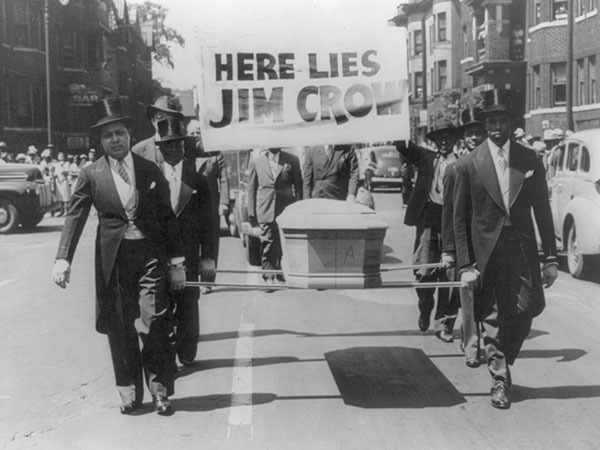 African Americans carry a casket down the street under a banner reading "Here Lies Jim Crow." Library of Congress, LC-USZ62-35358.
African Americans carry a casket down the street under a banner reading "Here Lies Jim Crow." Library of Congress, LC-USZ62-35358. -
With the war against two of the most racist regimes in history won, hundreds of thousands of black servicemembers returned home with expectations of a more tolerant nation. Most were bitterly disappointed to discover that very little had changed at home. Segregation was still the law of the land, and racism was alive and well.
-
For many African American veterans, that disappointment became determination to create change. They fought against segregation and discrimination with the same sense of purpose that had defeated the Axis. It is no coincidence that many of the leading figures of the Civil Rights Movements of the 1950s and 1960s were veterans.
 As chief counsel for the National Association for the Advancement of Colored People (NAACP), Thurgood Marshall closely followed the court martial of the “Chicago 50” accused of mutiny following the Port Chicago disaster. His appeal won the men a retrial, but all 50 convictions were upheld. After the war, he won the landmark case Brown v. Board of Education in 1954, declaring school segregation to be unconstitutional. Later, Marshall became the first African American Supreme Court Justice in US history. Library of Congress, LC-USZ62-130748.
As chief counsel for the National Association for the Advancement of Colored People (NAACP), Thurgood Marshall closely followed the court martial of the “Chicago 50” accused of mutiny following the Port Chicago disaster. His appeal won the men a retrial, but all 50 convictions were upheld. After the war, he won the landmark case Brown v. Board of Education in 1954, declaring school segregation to be unconstitutional. Later, Marshall became the first African American Supreme Court Justice in US history. Library of Congress, LC-USZ62-130748. As chief counsel for the National Association for the Advancement of Colored People (NAACP), Thurgood Marshall closely followed the court martial of the “Chicago 50” accused of mutiny following the Port Chicago disaster. His appeal won the men a retrial, but all 50 convictions were upheld. After the war, he won the landmark case Brown v. Board of Education in 1954, declaring school segregation to be unconstitutional. Later, Marshall became the first African American Supreme Court Justice in US history. Library of Congress, LC-USZ62-130748.
As chief counsel for the National Association for the Advancement of Colored People (NAACP), Thurgood Marshall closely followed the court martial of the “Chicago 50” accused of mutiny following the Port Chicago disaster. His appeal won the men a retrial, but all 50 convictions were upheld. After the war, he won the landmark case Brown v. Board of Education in 1954, declaring school segregation to be unconstitutional. Later, Marshall became the first African American Supreme Court Justice in US history. Library of Congress, LC-USZ62-130748.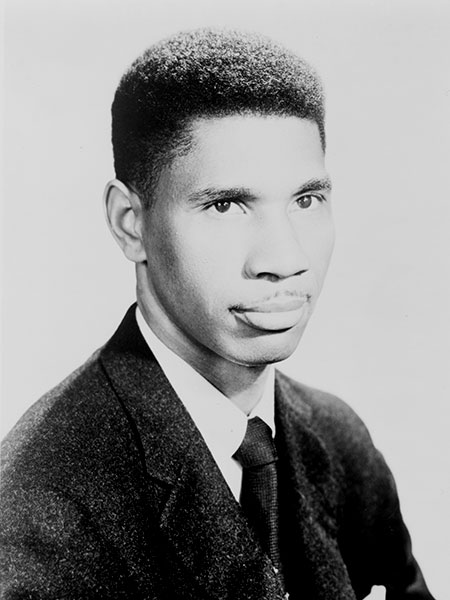 Growing up in the South, Medgar Evers was routinely subjected to discrimination, including random acts of violence. In the Army, he met many men who fought back against injustice. Evers returned home determined to continue the fight, and became one of Mississippi’s most active civil rights leaders. Early on the morning of June 12, 1963, Evers was assassinated by white supremacist Byron De La Beckwith, also a WWII veteran, who escaped conviction until 1994. Library of Congress, LC-USZ62-109400.
Growing up in the South, Medgar Evers was routinely subjected to discrimination, including random acts of violence. In the Army, he met many men who fought back against injustice. Evers returned home determined to continue the fight, and became one of Mississippi’s most active civil rights leaders. Early on the morning of June 12, 1963, Evers was assassinated by white supremacist Byron De La Beckwith, also a WWII veteran, who escaped conviction until 1994. Library of Congress, LC-USZ62-109400. Growing up in the South, Medgar Evers was routinely subjected to discrimination, including random acts of violence. In the Army, he met many men who fought back against injustice. Evers returned home determined to continue the fight, and became one of Mississippi’s most active civil rights leaders. Early on the morning of June 12, 1963, Evers was assassinated by white supremacist Byron De La Beckwith, also a WWII veteran, who escaped conviction until 1994. Library of Congress, LC-USZ62-109400.
Growing up in the South, Medgar Evers was routinely subjected to discrimination, including random acts of violence. In the Army, he met many men who fought back against injustice. Evers returned home determined to continue the fight, and became one of Mississippi’s most active civil rights leaders. Early on the morning of June 12, 1963, Evers was assassinated by white supremacist Byron De La Beckwith, also a WWII veteran, who escaped conviction until 1994. Library of Congress, LC-USZ62-109400. -
In December 1946, President Truman ordered the creation of the President's Committee on Civil Rights, which looked at the service of African American men and women in World War II. Its findings disproved the post-WWI War College study that had declared African Americans unfit to serve. They also stated officially what was already widely felt: black Americans did not enjoy the freedoms and liberties that they had fought and died to grant to others around the world.
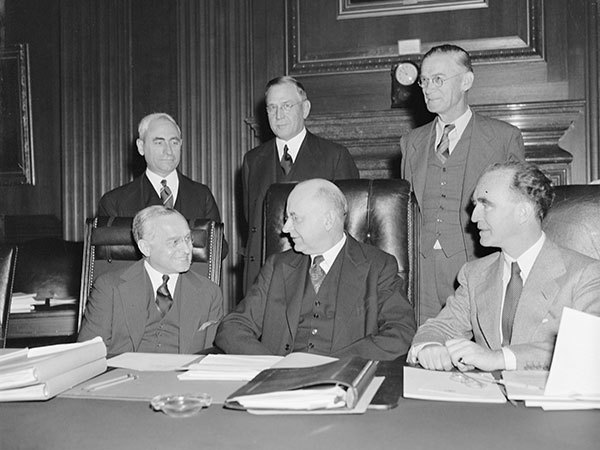 The members of the President's Committee on Civil Rights pose at the group's first public hearing. Library of Congress, LC-DIG-hec-27566.
The members of the President's Committee on Civil Rights pose at the group's first public hearing. Library of Congress, LC-DIG-hec-27566.
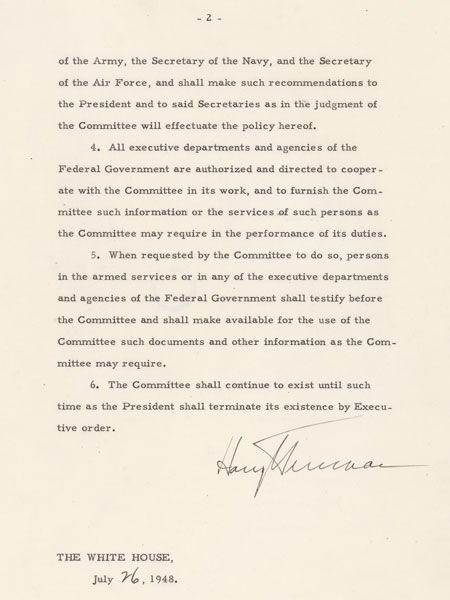 Executive Order 9981 was introduced by President Truman in 1948 to end segregation in the armed forces. Courtesy of the National Archives.
Executive Order 9981 was introduced by President Truman in 1948 to end segregation in the armed forces. Courtesy of the National Archives.
 Executive Order 9981, which President Truman introduced in 1948 to end segregation in the armed forces. Courtesy of the National Archives.
Executive Order 9981, which President Truman introduced in 1948 to end segregation in the armed forces. Courtesy of the National Archives. -
Medal of Honor Recipients
No African American servicemen received the Medal of Honor during World War II. However, thousands of black soldiers did see combat, and many distinguished themselves.
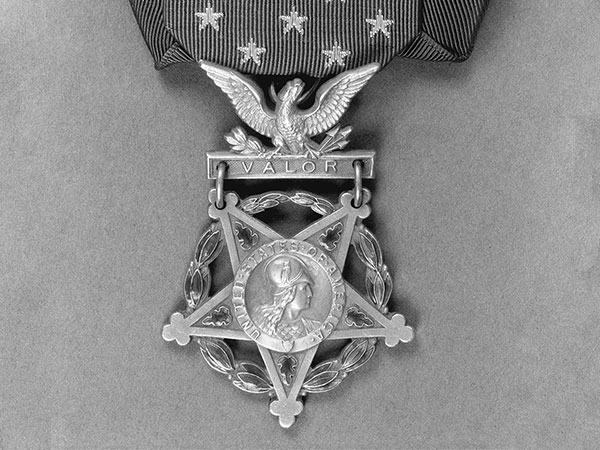 The Congressional Medal of Honor. Courtesy of the Congressional Medal of Honor Society.
The Congressional Medal of Honor. Courtesy of the Congressional Medal of Honor Society.Several of these servicemen were recommended for the Medal of Honor during the war, but the recommendations were lost or rejected due to an unwritten practice of denying the nation's highest military medal to African Americans.
More than 50 years after the war, President Bill Clinton ordered an investigation into this discriminatory practice. The result was a 1997 ceremony that awarded the medal belatedly to these seven men. When the freighter on which he was being transported was sunk, Private Watson pulled many men to life rafts before he became exhausted and drowned. He was originally awarded a posthumous Distinguished Service Cross, the first awarded to a black man in World War II. He was the only African American to receive the Medal of Honor for service in the Pacific Theater. Courtesy of the Congressional Medal of Honor Society.
When the freighter on which he was being transported was sunk, Private Watson pulled many men to life rafts before he became exhausted and drowned. He was originally awarded a posthumous Distinguished Service Cross, the first awarded to a black man in World War II. He was the only African American to receive the Medal of Honor for service in the Pacific Theater. Courtesy of the Congressional Medal of Honor Society. When the freighter on which he was being transported was sunk, Private Watson pulled many men to life rafts before he became exhausted and drowned. He was originally awarded a posthumous Distinguished Service Cross, the first awarded to a black man in World War II. He was the only African American to receive the Medal of Honor for service in the Pacific Theater. Courtesy of the Congressional Medal of Honor Society.
When the freighter on which he was being transported was sunk, Private Watson pulled many men to life rafts before he became exhausted and drowned. He was originally awarded a posthumous Distinguished Service Cross, the first awarded to a black man in World War II. He was the only African American to receive the Medal of Honor for service in the Pacific Theater. Courtesy of the Congressional Medal of Honor Society.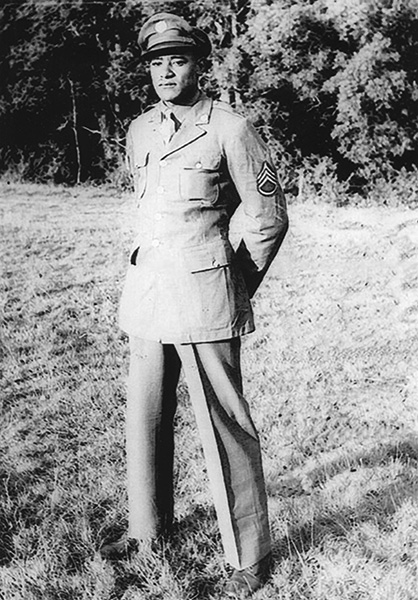 Staff Sergent Ruben Rivers distinguished himself in his first days in combat by jumping out of his tank to dismantle an enemy roadblock singlehandedly. A week later, Rivers was seriously wounded when his tank struck a mine—but he refused evacuation and continued to lead his tanks in an attack on the French town of Guebling. Courtesy of the Congressional Medal of Honor Society.
Staff Sergent Ruben Rivers distinguished himself in his first days in combat by jumping out of his tank to dismantle an enemy roadblock singlehandedly. A week later, Rivers was seriously wounded when his tank struck a mine—but he refused evacuation and continued to lead his tanks in an attack on the French town of Guebling. Courtesy of the Congressional Medal of Honor Society. Staff Sergent Ruben Rivers distinguished himself in his first days in combat by jumping out of his tank to dismantle an enemy roadblock singlehandedly. A week later, Rivers was seriously wounded when his tank struck a mine—but he refused evacuation and continued to lead his tanks in an attack on the French town of Guebling. Courtesy of the Congressional Medal of Honor Society.
Staff Sergent Ruben Rivers distinguished himself in his first days in combat by jumping out of his tank to dismantle an enemy roadblock singlehandedly. A week later, Rivers was seriously wounded when his tank struck a mine—but he refused evacuation and continued to lead his tanks in an attack on the French town of Guebling. Courtesy of the Congressional Medal of Honor Society. While leading a patrol towards Climbach, France, Charles Thomas and his men were ambushed by Germans . Despite serious injuries,, Thomas pulled his men to safety, deployed the rest of his patrol in covered positions, then refused evacuation for over an hour while he briefed his replacement and made sure that his men were in good positions. Courtesy of the Congressional Medal of Honor Society.
While leading a patrol towards Climbach, France, Charles Thomas and his men were ambushed by Germans . Despite serious injuries,, Thomas pulled his men to safety, deployed the rest of his patrol in covered positions, then refused evacuation for over an hour while he briefed his replacement and made sure that his men were in good positions. Courtesy of the Congressional Medal of Honor Society. While leading a patrol towards Climbach, France, Charles Thomas and his men were ambushed by Germans . Despite serious injuries,, Thomas pulled his men to safety, deployed the rest of his patrol in covered positions, then refused evacuation for over an hour while he briefed his replacement and made sure that his men were in good positions. Courtesy of the Congressional Medal of Honor Society.
While leading a patrol towards Climbach, France, Charles Thomas and his men were ambushed by Germans . Despite serious injuries,, Thomas pulled his men to safety, deployed the rest of his patrol in covered positions, then refused evacuation for over an hour while he briefed his replacement and made sure that his men were in good positions. Courtesy of the Congressional Medal of Honor Society. John Fox was serving as a forward artillery observer attached to the 366th Infantry Regiment when his position in Sommocolonia, Italy, came under attack. When his company abandoned the town, Fox stayed behind to call down artillery fire, and give the US forces time to get away. Fox called fire down closer and closer to his position, knowing that he would be killed. When the 92nd Infantry Division retook Sommocolonia, they found Fox's body surrounded by more than 100 dead German soldiers. Courtesy of the Congressional Medal of Honor Society.
John Fox was serving as a forward artillery observer attached to the 366th Infantry Regiment when his position in Sommocolonia, Italy, came under attack. When his company abandoned the town, Fox stayed behind to call down artillery fire, and give the US forces time to get away. Fox called fire down closer and closer to his position, knowing that he would be killed. When the 92nd Infantry Division retook Sommocolonia, they found Fox's body surrounded by more than 100 dead German soldiers. Courtesy of the Congressional Medal of Honor Society. John Fox was serving as a forward artillery observer attached to the 366th Infantry Regiment when his position in Sommocolonia, Italy, came under attack. When his company abandoned the town, Fox stayed behind to call down artillery fire, and give the US forces time to get away. Fox called fire down closer and closer to his position, knowing that he would be killed. When the 92nd Infantry Division retook Sommocolonia, they found Fox's body surrounded by more than 100 dead German soldiers. Courtesy of the Congressional Medal of Honor Society.
John Fox was serving as a forward artillery observer attached to the 366th Infantry Regiment when his position in Sommocolonia, Italy, came under attack. When his company abandoned the town, Fox stayed behind to call down artillery fire, and give the US forces time to get away. Fox called fire down closer and closer to his position, knowing that he would be killed. When the 92nd Infantry Division retook Sommocolonia, they found Fox's body surrounded by more than 100 dead German soldiers. Courtesy of the Congressional Medal of Honor Society.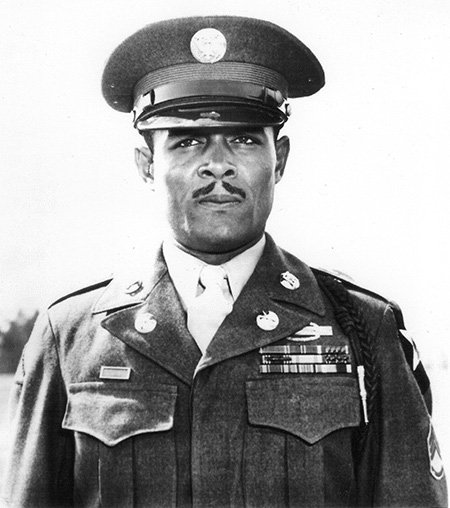 Edward Carter, Jr.'s unit came under attack while advancing toward Speyer, Germany. Carter led a patrol toward the town, but all of his men were killed or wounded. Despite being hit five times, Carter destroyed two enemy positions, killed several German soldiers, and captured two others who provided valuable intelligence that allowed US forces to advance. Courtesy of the Congressional Medal of Honor Society.
Edward Carter, Jr.'s unit came under attack while advancing toward Speyer, Germany. Carter led a patrol toward the town, but all of his men were killed or wounded. Despite being hit five times, Carter destroyed two enemy positions, killed several German soldiers, and captured two others who provided valuable intelligence that allowed US forces to advance. Courtesy of the Congressional Medal of Honor Society. Edward Carter, Jr.'s unit came under attack while advancing toward Speyer, Germany. Carter led a patrol toward the town, but all of his men were killed or wounded. Despite being hit five times, Carter destroyed two enemy positions, killed several German soldiers, and captured two others who provided valuable intelligence that allowed US forces to advance. Courtesy of the Congressional Medal of Honor Society.
Edward Carter, Jr.'s unit came under attack while advancing toward Speyer, Germany. Carter led a patrol toward the town, but all of his men were killed or wounded. Despite being hit five times, Carter destroyed two enemy positions, killed several German soldiers, and captured two others who provided valuable intelligence that allowed US forces to advance. Courtesy of the Congressional Medal of Honor Society. Vernon Baker was ordered to take an enemy position at Castle Aghinolfi, Italy, on April 5, 1945. He was ordered to hold the position by his white commander, who soon fled the battlefield. Cut off and nearly surrounded, Baker exposed himself to enemy fire to cover the evacuation of his wounded men. By the time he abandoned the position on April 6, Baker had only six men left of the 26 he led into battle.
Vernon Baker was ordered to take an enemy position at Castle Aghinolfi, Italy, on April 5, 1945. He was ordered to hold the position by his white commander, who soon fled the battlefield. Cut off and nearly surrounded, Baker exposed himself to enemy fire to cover the evacuation of his wounded men. By the time he abandoned the position on April 6, Baker had only six men left of the 26 he led into battle.
Vernon Baker was the only living Medal of Honor recipient in 1997. Courtesy of the Congressional Medal of Honor Society. Vernon Baker was ordered to take an enemy position at Castle Aghinolfi, Italy, on April 5, 1945. He was ordered to hold the position by his white commander, who soon fled the battlefield. Cut off and nearly surrounded, Baker exposed himself to enemy fire to cover the evacuation of his wounded men. By the time he abandoned the position on April 6, Baker had only six men left of the 26 he led into battle.
Vernon Baker was ordered to take an enemy position at Castle Aghinolfi, Italy, on April 5, 1945. He was ordered to hold the position by his white commander, who soon fled the battlefield. Cut off and nearly surrounded, Baker exposed himself to enemy fire to cover the evacuation of his wounded men. By the time he abandoned the position on April 6, Baker had only six men left of the 26 he led into battle.
Vernon Baker was the only living Medal of Honor recipient in 1997. Courtesy of the Congressional Medal of Honor Society. On April 7, 1945, Willy James, Jr. volunteered to lead the attack on Lippoldsberg, Germany. While advancing towards the town, James saw his platoon leader fall. While running to his aid, James was struck and killed by German machinegun fire.
On April 7, 1945, Willy James, Jr. volunteered to lead the attack on Lippoldsberg, Germany. While advancing towards the town, James saw his platoon leader fall. While running to his aid, James was struck and killed by German machinegun fire.
There is no known photograph of Willy James, Jr. This drawing was commissioned by his widow. Courtesy of the Congressional Medal of Honor Society. On April 7, 1945, Willy James, Jr. volunteered to lead the attack on Lippoldsberg, Germany. While advancing towards the town, James saw his platoon leader fall. While running to his aid, James was struck and killed by German machinegun fire.
On April 7, 1945, Willy James, Jr. volunteered to lead the attack on Lippoldsberg, Germany. While advancing towards the town, James saw his platoon leader fall. While running to his aid, James was struck and killed by German machinegun fire.
There is no known photograph of Willy James, Jr. This drawing was commissioned by his widow. Courtesy of the Congressional Medal of Honor Society.
Seeds of the Civil Rights Movement
Presented in New Orleans by the Coca-Cola Foundation
Official Program Sponsor 
Media Partners



